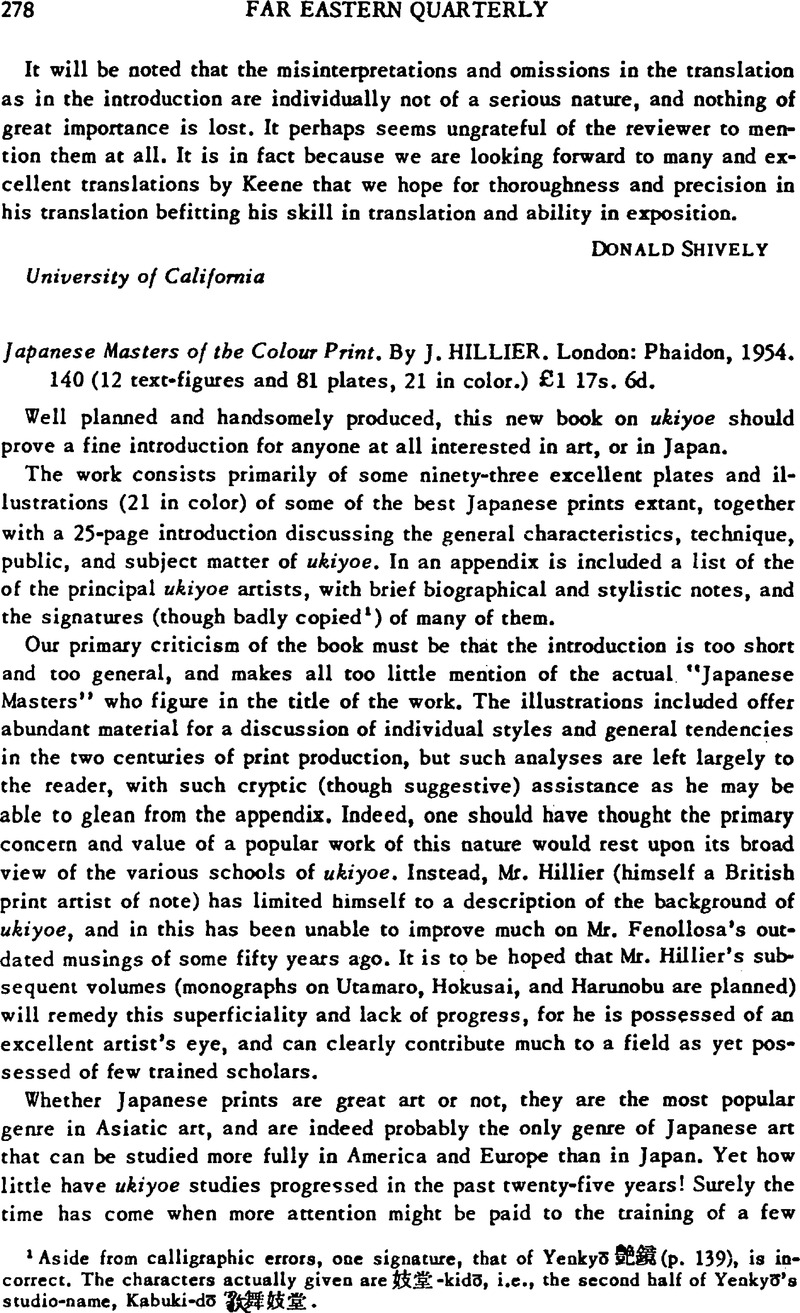No CrossRef data available.
Article contents
Japanese Masters of the Colour Print. By J. Hillier. London: Phaidon, 1954. 140 (12 text-figures and 81 plates, 21 in color.) £1 17s. 6d.
Published online by Cambridge University Press: 23 March 2011
Abstract

- Type
- Book Reviews
- Information
- Copyright
- Copyright © The Association for Asian Studies, Inc. 1955
References
1 Aside from calligraphic errors, one signature, that of Yenkyō ![]() (p. 139), is in correct. The characters actually given are
(p. 139), is in correct. The characters actually given are ![]() -kidō, i.e., the second half of Yenkyō's studio-name, Kabuki-dō
-kidō, i.e., the second half of Yenkyō's studio-name, Kabuki-dō ![]()
2 On this theme I would strongly recommend a reading of Dr. John A. Pope's stimulating article “Sinology or Art History: Some Notes on Method in the Study of Chinese Art,” Harvard Journal of Asiatic Studies 10 (1947), 388–417Google Scholar, much of which will apply equally here.
3 The following errata may be noted:
p. 7. makemono, read: makimono.
p. 9. The relationship of Matahei to ukiyoe is very problematic.
Fig. 1 (p. 10). Notes on the correct title (Kōshoku Ebon Taizen), date (1686), and other information on this rare book of Moronobu will be found in my “Study of Japanese Novels and Illustrated Books of the 17th and 18th Centuries in British Collections” (in Japanese), Saikaku Kenkyū 6 (1953), 189–190, 194–195.Google Scholar
Fig. 6 (p. 17) Danjuro: Danjūrō.
Fig. 8 (p. 21) Kitigawa: Kitagawa.
Plate 8. Sanjo: Sanjō.
Pl. 13. Kikujoro: Kikugorō. Pl. 41. Suguwara: Sugawara.
Pl. 43. Toshūsai: Tōshūsai (Pl. 48, 49, 50, likewise). Yawazō: Yaozō.
Pl. 45. Tagosode: Tagasode.
Pl. 48. Kosagawa Tsuneyō: Osagawa Tsuneyo.
Pl. 49. Nukajima Watayeimon: Nakajima Wadayemon.
Pl. 51. “… Beauties of Nanboku”: the title of the series is Tōzai Namboku no Bijin, “Beauties of All the Four Quarters,” that reproduced being a “downtown” girl of Yedo.
Pl. 54. “Scene from the ‘Genji Romance’”: actually from the Ise Monogatari, as clearly labelled. (The middle verse is, it happens, quoted also in the Genji Monogatari, in the chapter called Habakigi.)
Pl. 58. Kubō: Kubo.
Pl. 63. Kasagaṉō: Kasugano.
Pl. 68. Otaṉi: Otani.
PI. 76. Oi: Oi.
(In general, however, the publishers must be commended on their attempt to keep so many long-marks in place).
Students of Japanese literature will be amused to note Koryūsai's treatment of Bashō's famous “Old Pond” theme, in Plate 21.
The appendix, “Notes on the Artists” (p. 129–137), includes various minor points with which issue may be taken, e.g. (taking the first page only), Moronobu's dates (p. 129), “1625–1694”: His first signed work is.of 1672; nor does his unsigned work greatly pre-date this. From various circumstantial evidence, “ca. 1635–45” would seem a better guess for year of birth. (The book of 1658 mentioned has no relation to Moronobu.)
In the note on Sugimura Jihei (p. 129), it is his surname, Sugimura, not “Masataka,” that is worked into the designs.
Sub Nishikawa Sukenobu (p. 129), his first book illustrations date from about 1699, not 1710.
Sub Torii Kiyomasu I, Torii Kiyonobu II, Torii Kiyomasu II (p. 130), “Their work was devoted almost entirely to the stage”: This is hardly correct even in the field of prints, but particularly in the field of book illustration is there an extensive Torii output quite unrelated to the theatre. The dates given for Torii Kiyomasu I (“1696?–1716?”) are, incidentally, rendered improbable by the existence of a signed illustrated book of the very year, 1696, of his supposed birth. This work is described by Mr. Kenji Toda in his Descriptive Catalogue of Japanese and Chinese Illustrated Books in the Ryerson Library of the Art Institute of Chicago (Chicago 1931), pp. 120–121Google Scholar. The Ryerson copy lacks the title, and Book I, but from the description given, this is clearly the novel Kōsboku Tsuya Komoso, by the Edo novelist Tōrindō Chōmaro.




